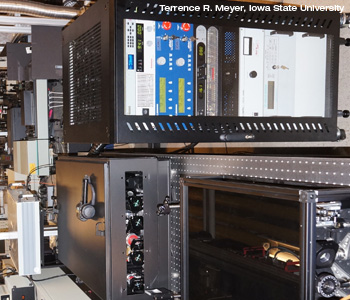May 3 2012
In the search for alternative fuels, scientists need tools to take snapshots of combustion reactions that happen at short time scales. American researchers have devised a new-type of burst-mode laser that provides bursts lasting 10 times longer than previous examples—enough to enable “movies” of these reactions.
The “quasi-continuous” system takes a pulsed-laser signal and concentrates the energy into longer “bursts,” according to Terrence R. Meyer, assistant professor of mechanical engineering at Iowa State University. Previous designs limited the laser burst to about 1.5 ms in duration, insufficient for studying the details of flame turbulence.
 The laser built by a team at Iowa State University, Spectral Energies LLC and the U.S. Air Force Research Laboratory.
The laser built by a team at Iowa State University, Spectral Energies LLC and the U.S. Air Force Research Laboratory.
Exciting the target molecules and generating enough signal to image their reaction requires the energy levels of a pulse-burst laser, Meyer said. Also, higher-energy bursts give researchers more flexibility in performing frequency conversion to study different chemical species.
Meyer and his colleagues at Iowa State, Spectral Energies LLC (Dayton, Ohio) and the U.S. Air Force Research Laboratory built the system around a narrow-linewidth pulsed fiber laser as the master oscillator. For the first time in a burst-mode laser, the researchers used an electro-optic modulator to reduce unwanted amplified spontaneous emission. Finally, the system relied on diode-pumped solid-state amplifiers instead of flashlamp-pumped amplification; the former has about 10 times the efficiency of the latter, according to Meyer.
To demonstrate what the laser system can do, the team performed planar laser-fluorescence imaging of a mixture of formaldehyde in a methane-air flame illuminated by the laser. At that time, the system still was using a combination of diode-pumped and flashlamp-pumped amplifiers. The team caught 10-ms-long, 200-image sequences with laser pulse energy of up to 150 mJ at 1,064.3 nm, as reported in the Optics Letters paper. Since submitting the article, the researchers switched the remaining flashlamp-pumped amplifiers to their diode-pumped counterparts and realized 30-ms-long sequences.
Any kind of gas-phase spectroscopy would benefit from this type of burst-mode laser, according to Meyer. It also could be used to pump an optical parametric oscillator to study other types of intermediate chemical species in the combustion process.
Meyer’s team included Mikhail Slipchenko and Sukesh Roy of Spectral Energies, James Gord and Stephen Danczyk of AFRL and Iowa State doctoral student Joseph Miller.
Source: OPN